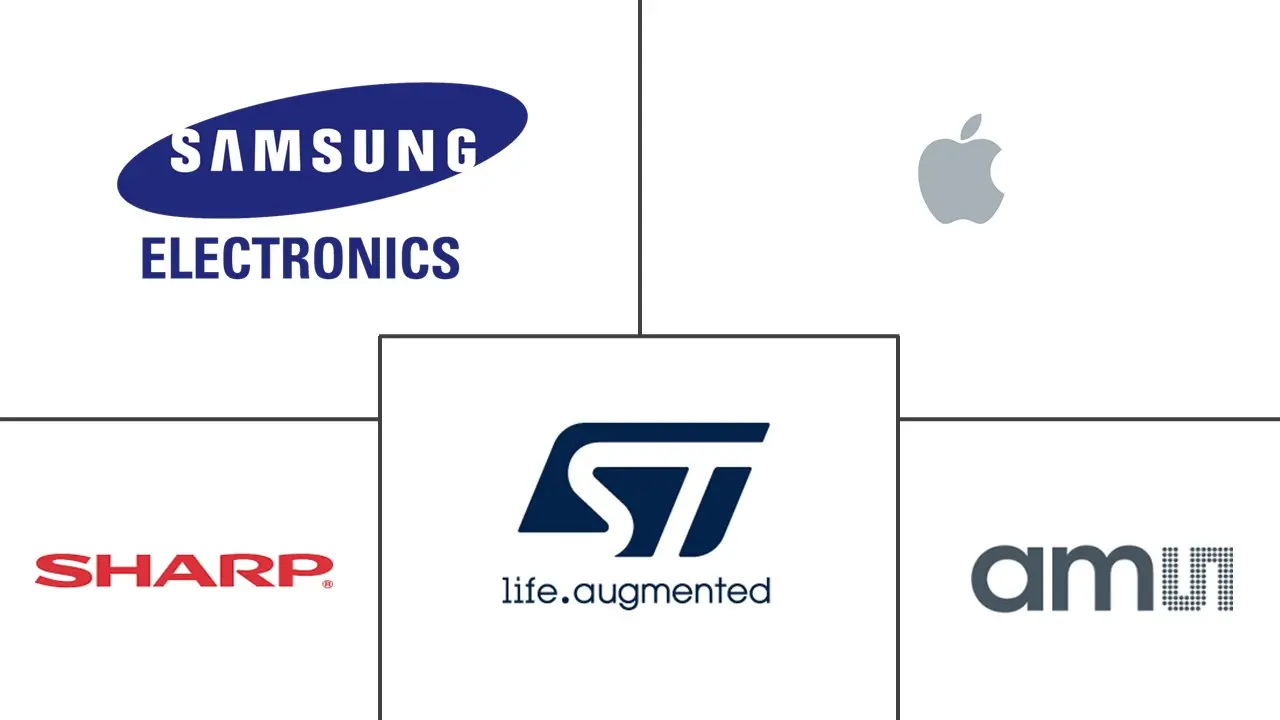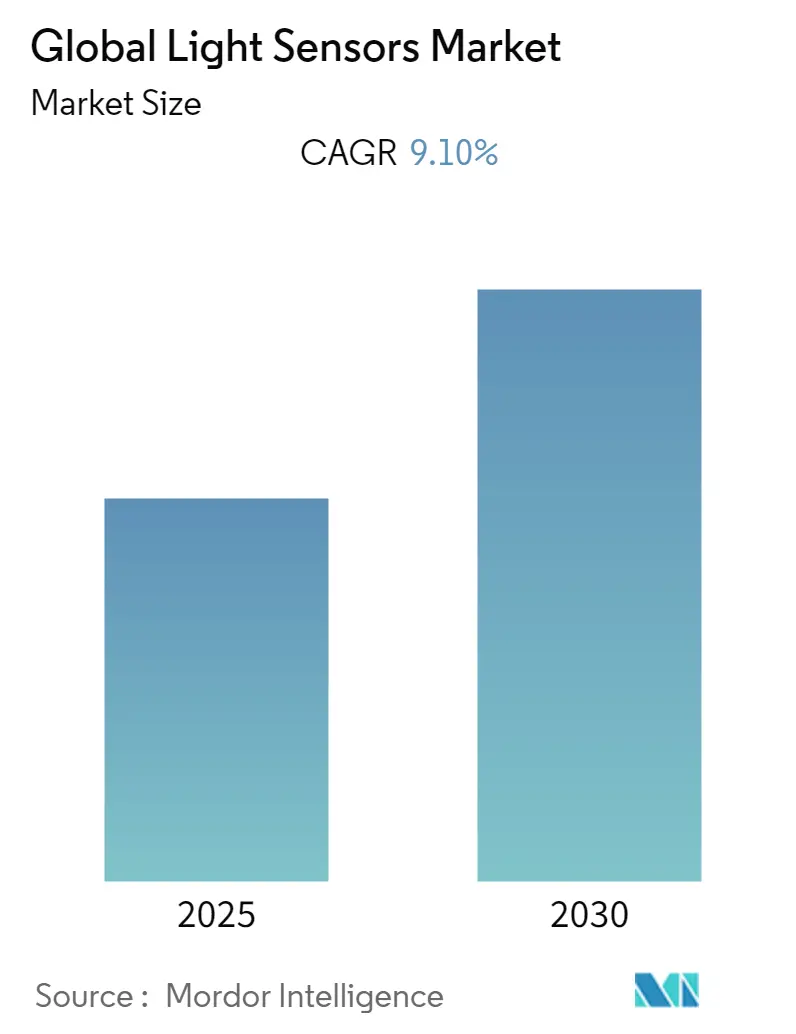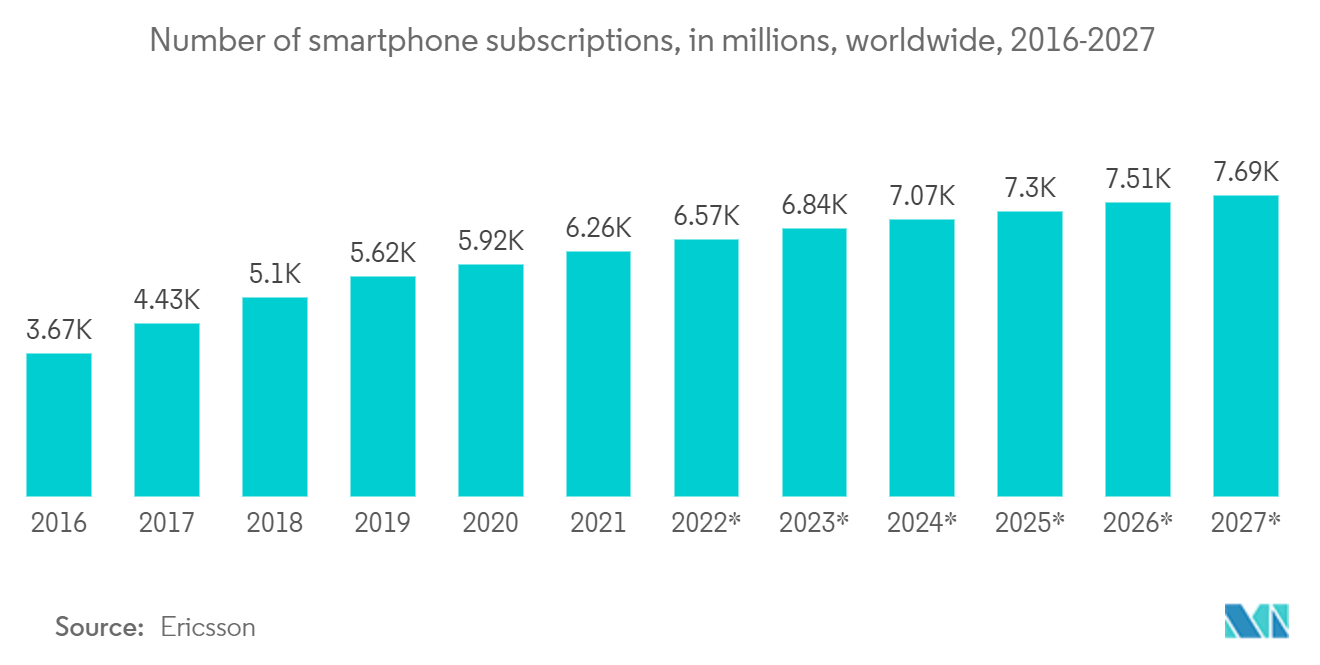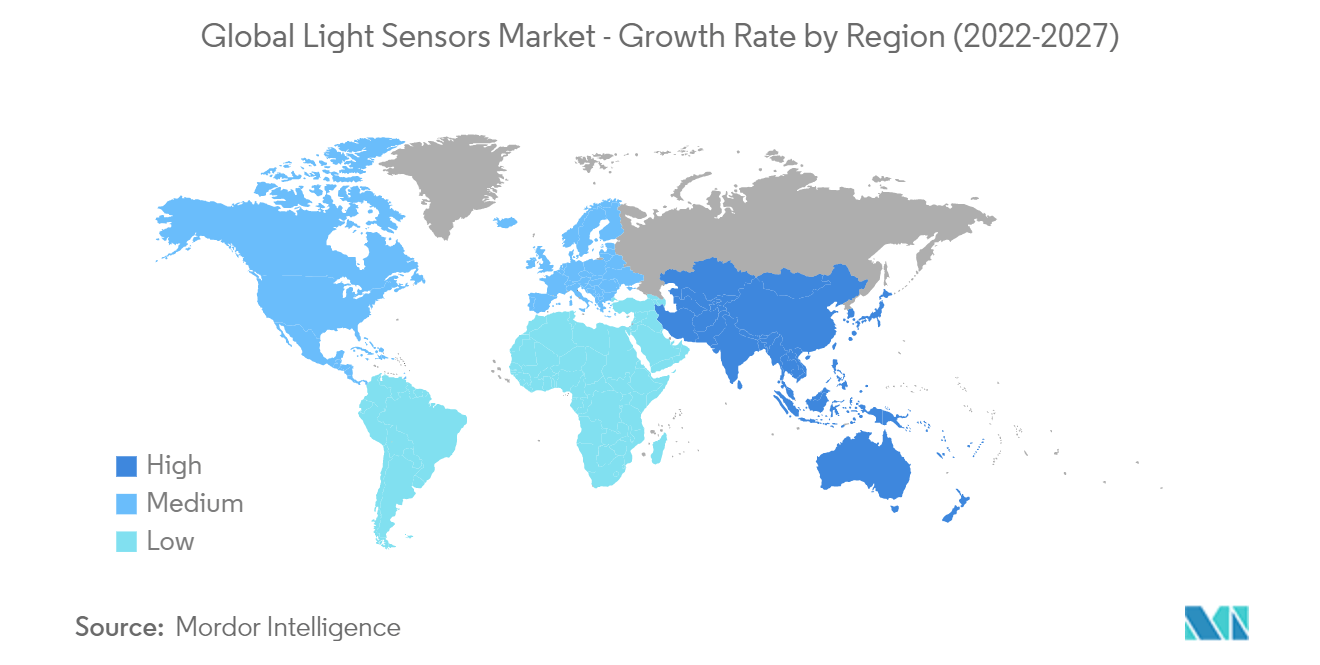Light Sensors Market Analysis
The Global Light Sensors Market is expected to register a CAGR of 9.1% during the forecast period.
- For instance, proximity light sensors respond to changes in infrared light to detect motion or proximity to another object. They are used for devices in vehicles that sound an alarm when the vehicle is close to bumping into an object. Proximity light sensors are common in outdoor lights to detect motion for security purposes.
- Smartphone manufacturers are actively incorporating new technologies into their devices to improve their product quality in terms of product quality and vision. For instance, in April 2022, Oppo announced that its model, Oppo F21 Pro, will feature the flagship Sony IMX709 RGBW selfie sensor that is 60% more sensitive to light and reduces noise by 35% when compared to the previous generation IMX615 RGB sensor.
- In the automotive segment, with the development of new technologies such as lane assist, automatic headlights, and many more, these sensors are being integrated into rear-view mirrors, interior lighting, side-view mirrors, rain sensor, optical control knobs, and many more. Also, the increased adoption of LiDAR sensors in various industry verticals, such as aerospace and defense, corridor mapping and topographical survey, automotive, mining, and oil and gas, has also created growth opportunities for the light sensors market across industries.
- During the Covid-19 pandemic, the consumer electronics sector's growth rapidly changed, increasing competition among market players. Consumer electronics manufacturers are currently under enormous pressure to bring unique and differentiated products to market. Major smartphone manufacturers like Samsung collaborate with light sensor manufacturers to integrate both technologies. For instance, in November 2021, MacDermidAlpha Electronics Solutions announced a collaboration with STMicroelectronics, a global semiconductor leader helping customers across the spectrum of sensing applications, on a key sinter technology for Electric Vehicles inverter assemblies to increase vehicle efficiency and range while lowering production costs significantly.
- Due to the massive COVID-19 outbreak, people's priorities shifted to technology and health, increasing demand for ambient light sensors in applications such as medical devices. For instance, in October 2021, Osram developed an ambient light sensor for mobile devices and wearables that detects UV-A light. According to the company, while the UV-C portion of sunlight is blocked by the earth's atmosphere, UV-A and UV-B radiation reach the earth's surface. Sunburn is caused by UV-B radiation, which only penetrates the upper layers of the skin. This COVID-19 crisis is expected to provide opportunities for businesses to invest in, implement, and research technologies requiring a less human touch. For example, consider the combination of AI and automation.
Light Sensors Market Trends
Consumer Electronics is Expected to Hold a Major Share
- The consumer electronics sector's expansion in the light sensors market has been propelled by the increasing use of proximity sensors and ambient light sensors in mobile devices. Due to a surge in the use of light sensors by the leading OEMs, including Samsung Electronics Co., Ltd., APAC may present prospects for growth (South Korea). The South Korean company Samsung Electronics Co., Ltd. is a significant player in the market for light sensors. It has integrated light sensors into a variety of product categories, including mobile devices like the Samsung Galaxy S6 and Samsung Galaxy S6 edge, that carry out specific tasks like proximity detection.
- Global demand for smart gadgets, such as LED televisions, smartphones, and smart lighting systems, has risen as a result of miniaturization and improvements in sensor technology. Different sensor technologies and communication interfaces are at the heart of these gadgets. The adoption of various sensors across sectors is projected to increase with the advent of connected products and 5G communication technology. Additionally, optical sensors are frequently employed in both residential and commercial wearable electronics equipment.
- Smartphones, LCD/LED televisions, and laptops are some of the applications that are driving the increase in demand for light sensor devices. As a result of the sensors' ability to automatically adjust the screen brightness based on how much ambient light these devices get, electricity savings are made possible. The control of lighting utilizing various digital sensing components involving illuminance detectors is another key emphasis of contemporary IoT lighting platforms.
- The proximity detection module and integrated ambient light sensor from AMS AG were released in July 2020, enabling mobile handset Original Equipment Manufacturers (OEMs) to create mobile handsets with almost bezel-less screens. In comparison to other devices on the market, the module (TMD2755) is 40% lower in area and 60% smaller in volume. Moreover, TMD2755 aids mobile phone manufacturers' efforts to expand the viewable display area by allowing the light-sensing and proximity features to be contained in a thinner bezel. This has been cited as a major contributor to rising consumer interest in mobile phones in the mid-range market segment.
- Electronic devices like mobile phones, LCDs, and LEDs are increasingly using light sensor devices to automatically alter the screen brightness in reaction to the quantity of light they are exposed to. This capability helps these devices conserve electricity. Light sensors are expanding in this market as a result of the growing focus on using facial recognition in consumer electronics, such as mobile phonesand tablets, for access and authentication, account accessibility, and security/identity fraud protection.
- The surge in the adoption of wearable devices and innovative applications in the biomedical sector may boost the growth of the market. However, the extra costs incurred due to the incorporation of sensors in devices and reduction in the life of the device are expected to hinder the market growth.
Asia-Pacific is Expected to Register a Significant Growth Rate
- Asia-Pacific is expected to dominate the light sensors market, owing to its larger population size and increasing demand and production of smartphones and other consumer electronics. For instance, according to India Cellular and Electronics Association (ICEA), the value of mobile phone production in India increased from INR 1,700 billion in 2019 to INR 2,149 billion in 2020. In 2021, the value totaled to INR 2,227 billion, despite the impact of the coronavirus pandemic.
- An increase in the adoption rate of handheld devices with inbuilt light sensors is also one of the key factors contributing to the growth of the light sensors market in the region.
- With an increase in the safety concerns among the consumers in the developing economies, such as India and the ASEAN countries, the automobile manufacturers are incorporating more sensors in low-cost vehicles. This is expected to drive the demand for light sensors in the foreseeable future.
- Further, the growing emphasis on the adoption of the latest technologies, such as the Internet of Things (IoT), facial recognition, and government regulations in the emerging economies to enhance security across various industry verticals are leading to increased deployment of light sensors, which is, in turn, boosting the growth of the industry in the region.
- The COVID-19 outbreak is also expected to impact the growth of the Light sensors market share. Primarily due to the governments in China, Japan, and Singapore starting to invest in the development of smart cities. Furthermore, the widespread use of light sensors in scanners, Quick Response (QR) codes, and intrusion detection systems (IDS) is driving market expansion.
Light Sensors Industry Overview
The light sensors market is fragmented, due to many large and small players churning the competition in the market. Through product and technology launches, strategic partnerships, acquisitions, expansions, and collaborations, these players are trying to gain a competitive edge in the market.
- July 2022 - The Optoelectronics group of Vishay Intertechnology, Inc. introduced a new AEC-Q101-qualified reflective optical sensor for automotive, smart home, industrial, and office applications. Offering a lower profile than previous-generation solutions while delivering improved performance with a higher current transfer ratio (CTR) and operating temperature, the Vishay Semiconductors VCNT2025X01 integrates an infrared emitter, silicon phototransistor detector, and daylight blocking filter in a miniature 2.5 mm by 2.0 mm by 0.6 mm surface-mount package.
- July 2021 - Sharp Semiconductor Co., Ltd. announced the development of the GP2AP130S00F proximity sensor for wearable devices that supports the I2C communication protocol. Its low current consumption design with an average current consumption of 40 μA (typ.) enables long-duration operation on battery power.
Light Sensors Market Leaders
-
STMicroelectronics NV
-
AMS AG
-
Sharp Corporation
-
Apple Inc.
-
Samsung Electronics Co. Ltd
- *Disclaimer: Major Players sorted in no particular order
Light Sensors Market News
- July 2022 - STMicroelectronics, a global semiconductor company serving customers across the spectrum of electronics applications, unveiled its latest FlightSense Time-of-Flight (ToF) multi-zone sensor. Delivered together with a suite of valuable software algorithms, the combination offers a turnkey solution for user detection, gesture recognition, and intruder alert, specially developed for the PC market.
- October 2021 - ams OSRAM, a global player in optical solutions, launched an ambient light sensor with proprietary UV-A light detection. Monitoring vital signs like pulse or oxygen saturation in the blood via smartphones and smartwatches has been available for several years. The corresponding UV channel of the TSL2585 from ams OSRAM detects the amount of UV-A radiation in natural sunlight. This enables the user to be warned of excessive UV-A radiation. Further, the sensor is suitable for space-constrained wearable and other mobile applications due to its highly compact dimensions.
Light Sensors Industry Segmentation
Light sensors detect and react to different levels of light in appliances, switches, and machines. Light sensors vary from those that respond to changes, collect current, or hold voltage depending on light levels. Light sensors are used for motion lights and robot intelligence, among other applications. These sensors are capable of detecting light that is not visible to the human eye, such as X-rays, infrared, and ultraviolet light.
The Global Light Sensors Market is Segmented by Type (Ambient Light Sensing, Proximity Detector, and RGB Color Sensing, Gesture Recognition, UV/Infrared Light (IR) Detection), Output (Analog and Digital), End-user Industry (Consumer Electronics, Automotive, Industrial), and Geography.
| Type | Ambient Light Sensing |
| Proximity Detector | |
| RGB Color Sensing | |
| Gesture Recognition | |
| UV/Infrared Light (IR) Detection | |
| Output | Analog |
| Digital | |
| End-user Industry | Consumer Electronics |
| Automotive | |
| Industrial | |
| Other End-user Industries | |
| Geography | North America |
| Europe | |
| Asia-Pacific | |
| Latin America | |
| Middle-East and Africa |
Light Sensors Market Research FAQs
What is the current Global Light Sensors Market size?
The Global Light Sensors Market is projected to register a CAGR of 9.1% during the forecast period (2025-2030)
Who are the key players in Global Light Sensors Market?
STMicroelectronics NV, AMS AG, Sharp Corporation, Apple Inc. and Samsung Electronics Co. Ltd are the major companies operating in the Global Light Sensors Market.
Which is the fastest growing region in Global Light Sensors Market?
Asia Pacific is estimated to grow at the highest CAGR over the forecast period (2025-2030).
Which region has the biggest share in Global Light Sensors Market?
In 2025, the North America accounts for the largest market share in Global Light Sensors Market.
What years does this Global Light Sensors Market cover?
The report covers the Global Light Sensors Market historical market size for years: 2019, 2020, 2021, 2022, 2023 and 2024. The report also forecasts the Global Light Sensors Market size for years: 2025, 2026, 2027, 2028, 2029 and 2030.
Our Best Selling Reports
Light Sensors Industry Report
Statistics for the 2025 Global Light Sensors market share, size and revenue growth rate, created by Mordor Intelligence™ Industry Reports. Global Light Sensors analysis includes a market forecast outlook for 2025 to 2030 and historical overview. Get a sample of this industry analysis as a free report PDF download.







